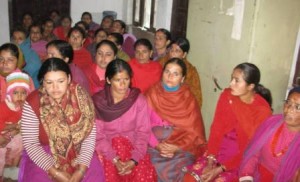India and Nepal are two neighboring countries that have a lot of similarities and a few differences. Often times you would hear the phrase “same same but different” in reference to contrasting the two. My own personal experience aligns quite well with this.
Like India, women in Nepal wear salwaar kameez and saris, adorned with glass bangles and bindis. Married women wear red. Shawls and sweaters have similar fabric (wool and pashmina) and patterns.  Married men wear an angular Nepali cap, which is different.
Married men wear an angular Nepali cap, which is different.
Majority Nepalis are Hindus so the culture and traditions are quite similar to those in India. Joint family system, arranged marriages, respect for elders are some common values.
Nepali is the main language in Nepal, but most people also speak English or Hindi. I found Nepali to have a lot of common words with several Indian languages (there are 13 officially in India) which made it relatively easy for me to understand. I could initiate a conversation in Hindi with almost everyone and they would understand.
The food is quite similar as well. A typical Nepali meal is daal (lentils), bhaat (steamed rice) and sabzi (curried vegetables). This is common in Indian households too. Northern India tends to add more meat and wheat (bread) dishes to their meals but the three staples are eaten across the country. There are mithai (sweet) shops in Nepal that are identical to those in India, selling snacks, street food and sweets. One needs to watch where they eat from for fear of diseases. Un-bottled water is strictly a no-no.
Bollywood is a major source of entertainment in both India and Nepal. Everyone seemed to be caught up with the latest movies and hit songs. My TV set in the hotel room had multiple Indian channels (perhaps more than Nepali) that broadcasted soaps, movies and music 24×7.
 Haggling when shopping is also a common experience. Nepali shopkeepers will offer you a price for an item and will quickly come down to as much as 33% of the original price, if you are a good negotiator. Like India, there are different entry fees to monuments, museums, etc. for residents and foreigners, sometimes the difference is as much as 15 times.
Haggling when shopping is also a common experience. Nepali shopkeepers will offer you a price for an item and will quickly come down to as much as 33% of the original price, if you are a good negotiator. Like India, there are different entry fees to monuments, museums, etc. for residents and foreigners, sometimes the difference is as much as 15 times.
The infrastructure is quite poor in Nepal, as it used to be in India before. There are mandatory power cuts for upto 18 hours a day to balance load shifting. Public places have dirty bathrooms and low hygiene conditions. Roads are bad and traffic congestion makes traveling small distances very time consuming. Like India, roads are meant for everyone from foot traffic, cows to motorcycles and buses. The pollution in Nepal is also worse than India. Overall, I felt like Nepal is now what India used to be 25 years ago.